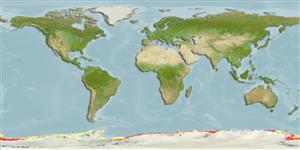Environment: milieu / climate zone / depth range / distribution range
Ecology
Marine; bathydemersal; depth range 371 - 915 m. Deep-water; 66°S - 79°S
Southern Ocean: Antarctic continental shelf and west of Adelaide Island at the Antarctic Peninsula.
Size / Weight / Age
Maturity: Lm ? range ? - ? cm
Max length : 13.0 cm SL male/unsexed; (Ref. 5192)
Spawning may take place during middle to late summer. Distinguished from all other bathydraconid species by the short tubular section of the upper lateral line and the absence of the coronal pore.
Gon, O., 1990. Bathydraconidae. p. 364-380. In O. Gon and P.C. Heemstra (eds.) Fishes of the Southern Ocean. J.L.B. Smith Institute of Ichthyology, Grahamstown, South Africa. 462 p. (Ref. 5192)
IUCN Red List Status (Ref. 130435)
Threat to humans
Harmless
Human uses
Fisheries: of no interest
Tools
Special reports
Download XML
Internet sources
Estimates based on models
Preferred temperature (Ref.
123201): -1.8 - 0.8, mean -0.8 °C (based on 568 cells).
Phylogenetic diversity index (Ref.
82804): PD
50 = 1.0000 [Uniqueness, from 0.5 = low to 2.0 = high].
Bayesian length-weight: a=0.00224 (0.00117 - 0.00427), b=3.25 (3.07 - 3.43), in cm total length, based on LWR estimates for this (Sub)family-body shape (Ref.
93245).
Trophic level (Ref.
69278): 3.5 ±0.4 se; based on size and trophs of closest relatives
Resilience (Ref.
120179): Medium, minimum population doubling time 1.4 - 4.4 years (Fec = 200).
Fishing Vulnerability (Ref.
59153): Low vulnerability (10 of 100).
